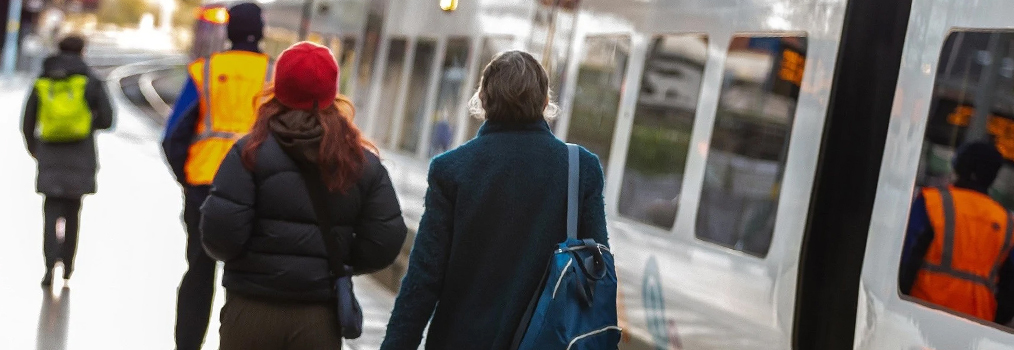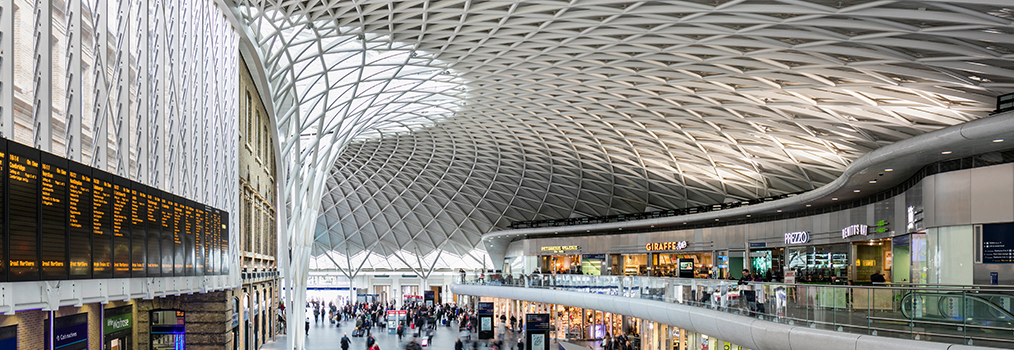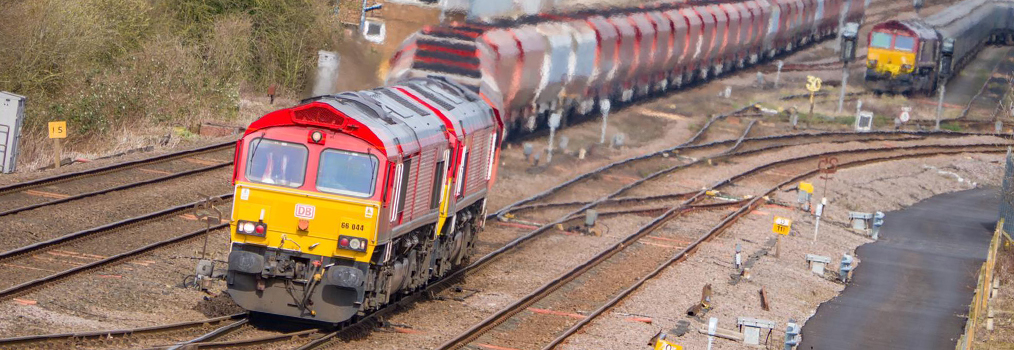NTS update confirms major shifts in rail trip making
Growth in education and leisure travel offset business travel losses
The Department for Transport (DfT) has published new data from its National Travel Survey*, combining data from the last six months of the 2022 survey with the first six of 2023. The limited number of tables predates publication of the full 2023 data later in the year.
The figures point to a continuing recovery from the Covid-19 pandemic, with overall trip rates increasing between the 2022 survey and these interim results. The public as a whole made an estimated 882 trips per person per year (tpppy) by all modes in 2022/23, up by 3.4 per cent compared with 2022. However, the figure remained 8.2 per cent below the 952.6 trips recorded in the 2019 survey. Shopping trips, for long the backbone of travel demand, also increased, up 2.7 per cent to 165.4 tpppy, compared with 2022’s figure of 151.1. Again, however, this was substantially down on pre-pandemic levels, when 180.6 tpppy were recorded. That’s a shortfall of 15.4%.
Looking specifically at the rail market in England, the overall trip rate forged ahead by 37 per cent, reaching 15.4 tpppy compared with 11.2 in 2022. The last pre-Covid figure recorded in 2019 was 22.1, leaving a shortfall of 30.6 per cent.
Analysis of responses on people’s reasons for making their journey, trip rates for all purposes except personal business increased between 2022 and the latest data, with the overall increase being 12.7 per cent. When comparing the 2022/23 trip rates with those of 2019, we see a sharp fall in many categories, but increases in travel for education and for leisure. The falls range from 44.8 per cent for business travel and 37.3 per cent for commuting to 3.4 per cent for shopping. The chart at Figure 1 illustrates the changes, but also shows the same figures for 2010, and we see that many of the gains made between 2010 and 2019 have been wiped out. The two purposes which show continuing falls across all three sample years – shopping and personal business – are those which have been most affected by the growth of online transactions.
Figure 1: Rail Trip Rates in England by Journey Purpose
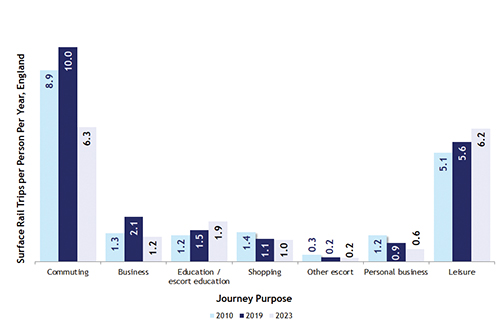
Translating those trip rates into estimated passenger numbers, we see from Figure 2 that the importance of commuting has diminished, now accounting for 36.2 per cent of trips, ten points lower than in 2019. The growth in leisure travel means that this now accounts for 35.8 per cent of passenger journeys, less than one per cent behind commuting. Business travel has fallen back from 9.8 per cent to 6.7 per cent, a fall that is particularly damaging in revenue terms. The change has wiped out a decade of steady growth and taken the market share back below 2010 levels. The increased importance of education is notable, as is a small rise in the importance of shopping.
Figure 2: Share of Rail Trips in England by Journey Purpose
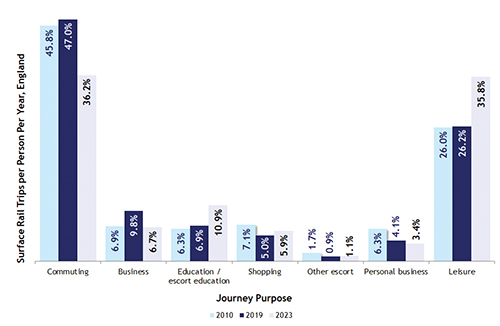
There have been some major shifts in the demographic profile of bus users, according to the survey, with trip rates falling amongst older people (see table). The overall recovery in 2022/23 was not universal: there were continuing falls in trip rates amongst those between 40 and 49 and between 50 and 59. The highest year-on-year growth came from those over 70, showing an increase of 44.3 per cent, closely followed by the under 17s on 41.2 per cent.
Comparing trip rates with the last pre-pandemic year, two age-groups, the under 17s and between 21 and 29, actually show an improvement of 33.8 per cent and 9.9 per cent respectively, but the others show sharp falls: this is as high as 43.4 per cent amongst the over 70s and 43.2 per cent for those in their fifties. All the age groups over 30 show a fall of over 30 per cent since 2019.
There are some significant differences in behaviour between men and women, with the latter showing much more significant falls in bus use since 2019 across all age groups, with the gap widening with age, so women in their sixties are making two-thirds fewer trips since the pandemic. Even so, women continue to have higher trip rates than men across all age groups save one, the twentysomethings.
Surface Rail Trip Rates in England by Age and Gender (trips per person per year)
| Item | All ages | <17 | 17-20 | 21-29 | 30-39 | 40-49 | 50-59 | 60-69 | 70+ |
| All People | |||||||||
| 2010 | 19.5 | 7.1 | 29.2 | 34.6 | 37.0 | 21.1 | 19.4 | 11.8 | 5.6 |
| 2019 | 21.2 | 6.5 | 36.4 | 31.5 | 36.0 | 30.3 | 24.4 | 15.5 | 7.2 |
| 2023 | 17.3 | 8.9 | 34.2 | 34.9 | 23.6 | 21.5 | 16.0 | 11.9 | 4.8 |
| Change since 2010 | (11.3%) | 24.8% | 17.0% | 1.1% | (36.3%) | 1.7% | (17.7%) | 1.4% | (14.4%) |
| Change since 2019 | (20.1%) | 33.8% | (7.7%) | 9.9% | (33.5%) | (41.8%) | (43.2%) | (30.1%) | (43.4%) |
| Males | |||||||||
| 2010 | 22.0 | 6.5 | 28.3 | 34.1 | 46.8 | 24.6 | 23.0 | 13.6 | 5.8 |
| 2019 | 24.9 | 6.1 | 45.3 | 31.7 | 43.6 | 42.2 | 28.5 | 15.7 | 7.8 |
| 2023 | 18.2 | 9.3 | 26.8 | 34.2 | 26.4 | 24.6 | 18.2 | 12.5 | 4.6 |
| Change since 2010 | (17.3%) | 42.5% | (5.3%) | 0.2% | (43.5%) | (0.1%) | (21.2%) | (8.5%) | (21.1%) |
| Change since 2019 | (30.7%) | 49.7% | (65.5%) | 7.2% | (36.7%) | (71.7%) | (44.9%) | (24.0%) | (55.1%) |
| Females | |||||||||
| 2010 | 17.1 | 7.7 | 30.1 | 35.0 | 27.4 | 17.7 | 15.8 | 10.0 | 5.3 |
| 2019 | 17.7 | 6.9 | 27.1 | 31.3 | 28.5 | 18.7 | 20.3 | 15.2 | 6.6 |
| 2023 | 16.5 | 8.4 | 41.8 | 35.7 | 20.9 | 18.5 | 13.9 | 11.4 | 4.9 |
| Change since 2010 | (3.6%) | 9.0% | 38.6% | 1.8% | (23.8%) | 4.5% | (12.3%) | 14.3% | (8.5%) |
| Change since 2019 | (6.9%) | 19.5% | 48.8% | 12.5% | (27.8%) | (1.0%) | (40.9%) | (38.2%) | (32.6%) |
Comment
This latest update to the National Travel Survey offers further confirmation, if it were needed, that the onset of the Covid-19 pandemic turned the market for rail services upside down. Historic patterns of use by journey purpose and demography changed completely, and almost two decades of steady growth in rail trip making were slammed into reverse.
This both echoes and reinforces figures from the DfT show that in the first three months of this year, which suggests if anything that demand started to go backwards. Patronage averaged just under 83 per cent of pre-pandemic levels excluding the Elizabeth Line between January and March. This compared with 87 per cent across the whole of 2023 and 79.3 per cent in 2022. This makes full recovery still seem a long way off.
The NTS update goes a long way to explaining the shortfall, mapping both the changes in journey purpose and in the age and gender of rail users. The loss of commuting trips is well known and understandable, given the moves towards working from home and hybrid working. It accounts for some 300 million trips a year compared with 2019 – pretty much the whole of the 307 million national shortfall. Business travel accounts for 76 million more but this loss is offset by gains in education and leisure travel.
The shifts in the age profile of users both reflects and influences this. The fall in commuter trips can be linked with the decline in trip rates amongst those between 30 and 59, whilst the increased amongst the under 17s can be linked to the rise in leisure travel, associated with more weekend family trips. The fall in trip rates amongst older people mirrors that seen in bus travel and can be attributed to ongoing nervousness about infection risks, but the strong recovery in 2022/23 amongst the over 70s offers hope of a further revival.
As so often in the past, then, the rail industry has had to withstand a storm whipped up by factors outside its control – not helped, though, by self-inflicted wounds of ongoing strikes and poor reliability in some areas. There are still many uncertainties about the future, but at least this sort of analysis enables greater understanding of where we’re at and helps identify some target markets for future growth.
Meanwhile, the future is very uncertain, driven by a further tech revolution from AI, the difficult economic and fiscal outlook post this year’s General Election and the need to do more to achieve Net Zero targets. All these and more impinge on our ability to see into the future. It’s already clear that this will have profound and unknowable impacts on the way we live and the way we travel. Flexibility and speed of response will be essential. Let’s hope that the new ownership framework can deliver this.
Also published in Rail Professional magazine.
* - The NTS is a household survey of personal travel, from data collected via interviews and a seven-day travel diary, which enables analysis of patterns and trends. The statistics for the year ending June 2023 include data from the second half of 2022 and the first half of 2023. In the year ending June 2023, the survey captured responses from 10,351 individuals covering 167,916 trips. The National Travel Survey mid-year estimates are available at https://www.gov.uk/government/statistics/national-travel-survey-mid-year-estimates-year-ending-june-2023.

